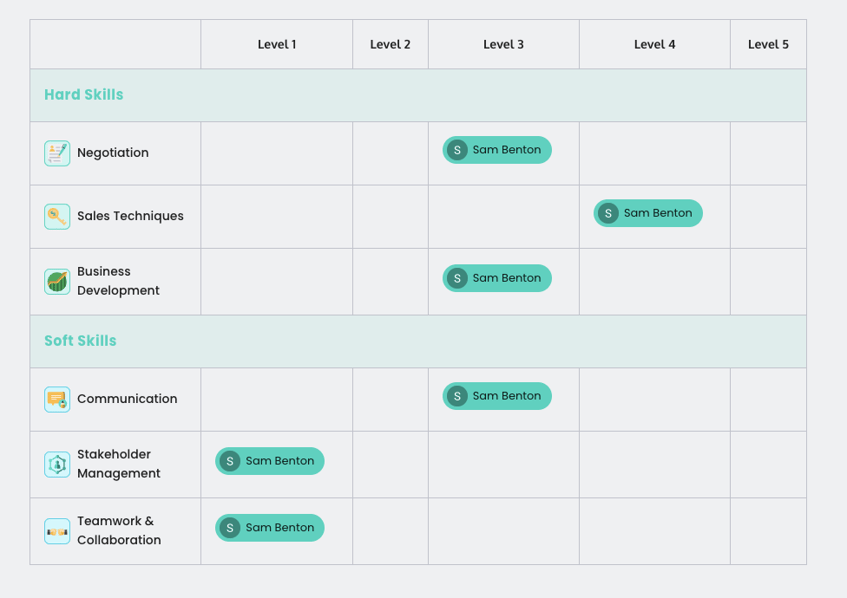As organisations grow and evolve, so do the needs of their employees. So what’s the best way to ensure your people always have the right skills for the job? A skills matrix - of course!
The famed skills matrix used by superstar HR teams across the globe has many names from skills taxonomy to competency matrix. But it does one key thing - helps organisations visualise what skills and competencies employees have and what they need to push further.
In this blog post, we’ll answer frequent questions relating to the skills matrix and explain why you should implement one in your organization.
What is a Skills Matrix?
A skill matrix maps out every skill required for a role to be performed effectively. By creating a skills matrix, an organisation can see where employees are succeeding and where skills gaps appear.
The most popular format is a grid with columns representing the skill and rows representing the levels of experience required for each skill.
In the 5Mins skill matrix below we can see Sam is highly skilled in sales techniques and other hard skills, but needs a hand to improve his soft skills.

The purpose of a Skill Matrix is to help identify gaps in your talent pool and determine a plan of action to improve team performance. Do you need to hire new employees? What skills need to be included in the new job ad? Which employees need help with focused training?
The Skill Matrix can also be a huge pillar in an overall talent management strategy to ensure that employees have the right skills so they can perform at their best consistently.
Why Is a Skills Matrix Important?
Having a detailed picture of your talent pool can benefit your workplace immensely - from recruiting talent to fill skill gaps to fast tracking growth of existing employees.
A skill matrix is often used as part of an organisation's human resource management (HRM) system. So HR can get a clear picture of how the organisation's workforce compares with their competitors and industry standard.
A skills matrix can be used to:
1. Identify training needs
A skill matrix allows you to see what skills are lacking and which ones are over-supplied within your organisation, allowing you to prioritise training that addresses these needs.
For example, if you have too many people with accounting qualifications but not enough people with marketing qualifications, then your company may need some extra marketing training for its existing staff members.
2. Assess performance
If your company uses a performance management system that includes rating performance against job descriptions, then a skill matrix can help you determine if any employees are not performing up to standard or whether they should be performing better than they currently are.
3. Identify competency gaps
A competency or skill gap refers to the difference between an employee’s competency level and the required level of performance in your organisation.
How to create a Skill Matrix?
Ready to map out your employees' development? Let’s see how you can create a personalised skills matrix, with a little help from 5Mins.
1. Identify the skills needed for your organisation
The first step towards creating an effective skills matrix is to create an accurate, standardised list of all the hard and power (or soft) skills that are required for each role within your organisation.
At 5Mins we have done most of the heavy lifting for you. We have analysed thousands of roles, job listings and academic research to create a comprehensive skills taxonomy with the most in-demand skills for every role. So now it’s even easier for you to get started.
2. Measure the level of competency
For each skill, you will want to know the employee’s proficiency. A grading system with levels helps to rank competency, level of skill and track growth over time.
For example, the rankings can range from 0 to 4, novice to expert, or basic to advanced. You can determine what is the best grading option for your organisation, that can easily be understood and standardised across different departments.
3. Evaluate your employees
Now you’re ready to evaluate your workforce. The most common ways to grade your employees’ skills are:
- Asking employees to self evaluate
- Asking managers to grade employees skills
- Completing skills assessments e.g. graded tests or quizzes
It’s great to use combined methods to evaluate your employees, so you get a crystal-clear overview of employee performance and skills level.
4. Analyse your results
Build a chart, create a map, go wild with visualising your newfound data! You will be able to discover insights right away to create a plan of action and strengthen your team dynamics.
How to build a Skill Matrix in Excel?
We have created a skills matrix template to help power your skills development. Our skills matrix spans across hundreds of roles and every department - from marketing to finance. You can download and use it right away or customise according to your team.
Download Now: Skills Matrix Template
Conclusion
Organizations become stronger when employees know their value and when leaders can identify and tap into that value. The skills matrix is an excellent tool to help organizations achieve this. This simple tool allows organizations to identify the skills and talents of their employees and use those to their advantage.
Now that you know what a skills matrix is and how you can use it, why wait? Ensure that your organization is primed for success and that employee needs are being met by implementing it.




